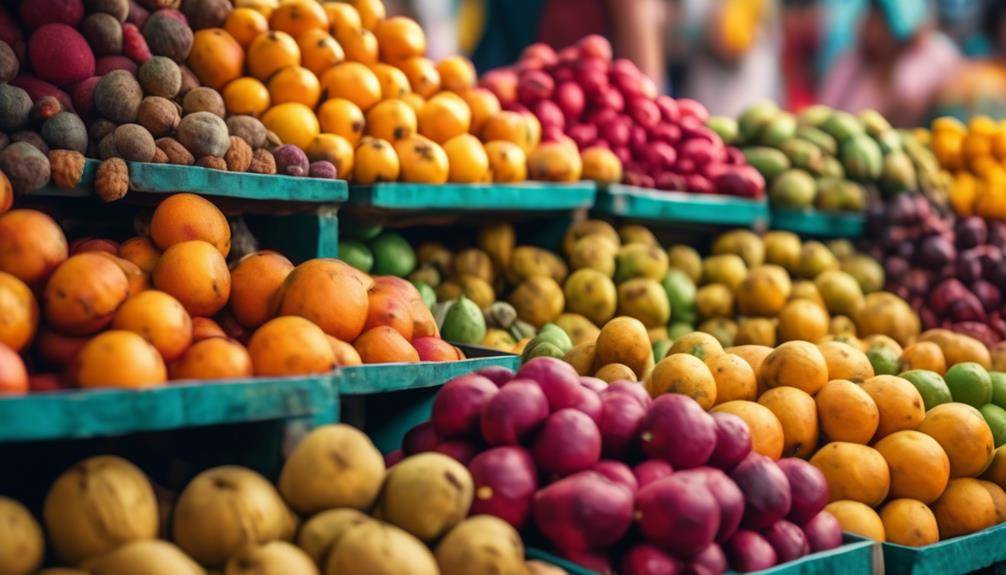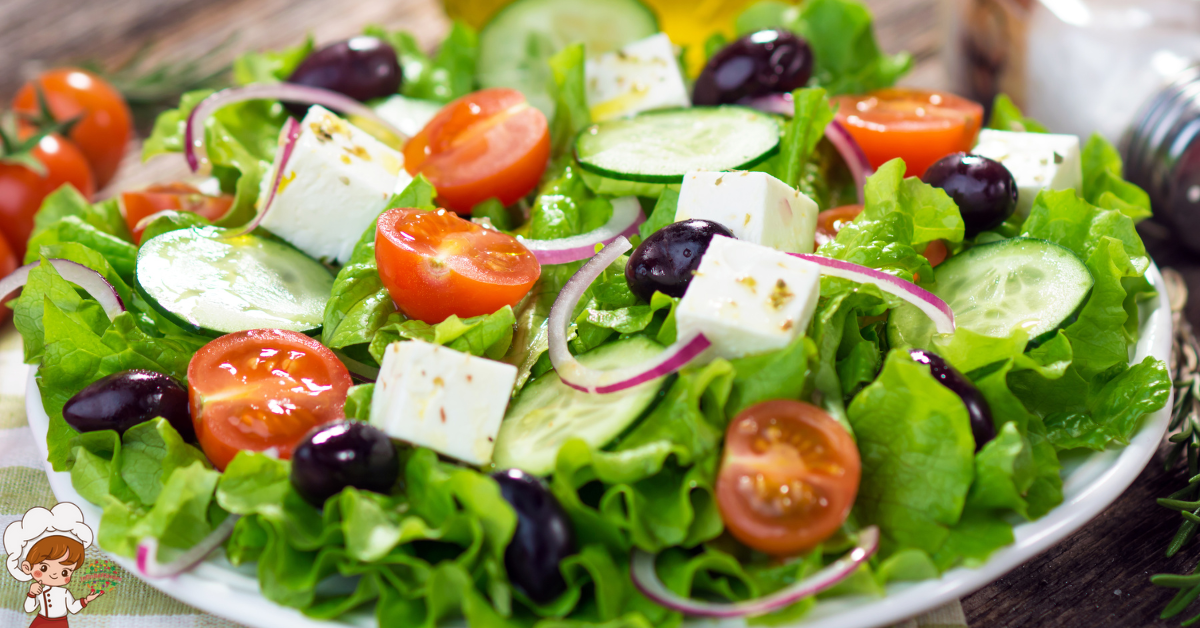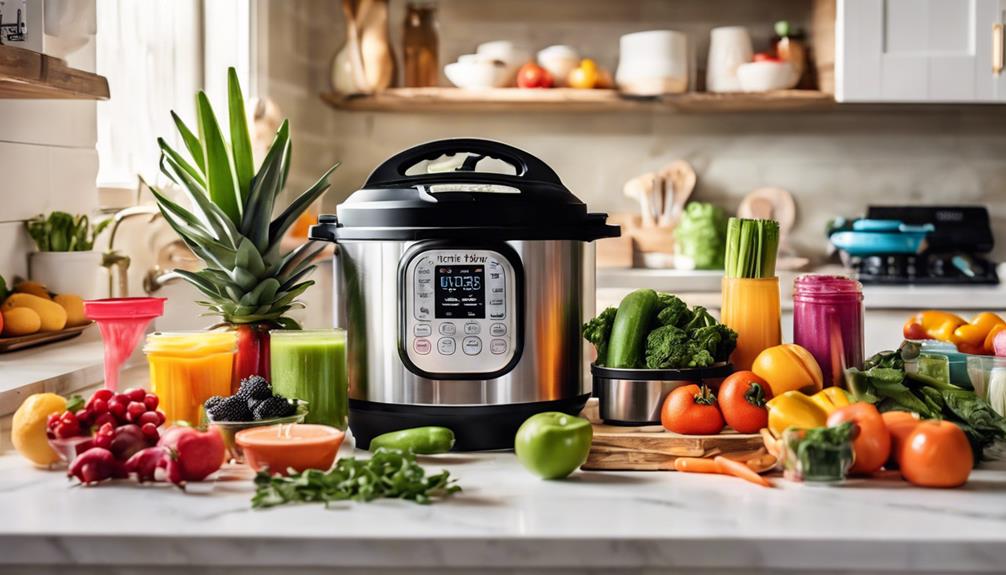Peruvian Cuisine And Its Use Of Exotic Fruits

Are you ready to embark on a culinary journey through the vibrant and flavorful world of Peruvian Cuisine And Its Use Of Exotic Fruits? Prepare yourself for an exploration of exotic fruits that will tantalize your taste buds and leave you yearning for more. In the land of the Incas, where ancient traditions meet modern innovation, the use of exotic fruits has become an integral part of the culinary tapestry. So, let us delve into the depths of Peruvian cuisine and discover the captivating role that these fruits play in creating dishes that are as visually stunning as they are delicious.
Peru’s Abundance of Exotic Fruits
Peru’s vibrant and diverse ecosystem is home to a remarkable array of exotic fruits, contributing to the country’s rich culinary heritage and captivating food culture. The cultural significance of these fruits in Peru cannot be overstated. For centuries, they have played a central role in Peruvian cuisine, not only for their unique flavors but also for their health benefits.
One of the most culturally significant fruits in Peru is the lucuma. Known as the “Gold of the Incas,” this fruit has been cultivated since ancient times. It was considered a sacred fruit by the Incas and was often used in religious ceremonies. Today, lucuma is still highly valued in Peruvian cuisine for its sweet, caramel-like flavor and creamy texture. It is commonly used in desserts such as ice cream, cakes, and puddings.
Another fruit with cultural significance is the camu camu. Native to the Amazon rainforest, this small red fruit is rich in vitamin C, making it a vital source of nutrition for the indigenous communities of Peru. Traditionally, camu camu was used to treat various ailments and boost the immune system. In modern Peruvian cuisine, it is used in juices, sauces, and even cocktails, adding a tangy and refreshing flavor.
In addition to their cultural significance, these exotic fruits also offer numerous health benefits. For instance, the camu camu is known for its antioxidant properties and its ability to support a healthy immune system. The lucuma, on the other hand, is a good source of vitamins and minerals, including beta-carotene, iron, and calcium. Incorporating these fruits into your diet can provide a flavorful way to boost your overall health and well-being.
Peru’s abundance of exotic fruits is not only a testament to its diverse ecosystem but also a reflection of its rich cultural heritage. From the sacred lucuma to the nutritious camu camu, these fruits have left an indelible mark on Peruvian cuisine. So, the next time you savor a Peruvian dish, take a moment to appreciate the cultural significance and health benefits that these exotic fruits bring to the table.
The Cultural Significance of Exotic Fruits in Peruvian Cuisine
Exotic fruits hold a profound cultural significance in Peruvian cuisine, showcasing the fusion of indigenous traditions, colonial influences, and culinary innovation. These fruits have been deeply ingrained in Peruvian cultural traditions for centuries and play a vital role in the country’s culinary landscape. The historical influences on Peruvian cuisine have shaped the use of exotic fruits, creating a unique and vibrant gastronomic experience.
Peruvian cuisine reflects the country’s rich cultural heritage, which includes indigenous, Spanish, African, and Asian influences. Exotic fruits have been an integral part of indigenous culinary traditions, with native communities incorporating them into their daily diets. These fruits were not only valued for their taste and nutritional benefits but also held spiritual and medicinal significance.
The arrival of the Spanish colonizers in the 16th century introduced new fruits to Peru, such as oranges, lemons, and mangoes. These fruits were quickly embraced by the local population and intermingled with the existing indigenous varieties. This blending of cultural traditions resulted in the creation of unique dishes that showcased the diversity of flavors and textures.
Over time, Peruvian cuisine continued to evolve, integrating culinary techniques and ingredients from other parts of the world. Exotic fruits from Africa and Asia, such as passion fruit, dragon fruit, and lychee, found their way into Peruvian recipes, further enriching the country’s gastronomy. This constant exchange of flavors and techniques illustrates the cultural dynamism and openness of Peruvian cuisine.
Today, the cultural significance of exotic fruits in Peruvian cuisine is evident in the wide variety of dishes that feature these ingredients. From refreshing fruit salads to exotic fruit-infused ceviche, these fruits add a burst of flavor and color to traditional Peruvian recipes. They not only enhance the taste but also serve as a representation of Peru’s diverse cultural heritage.
Exploring the Unique Flavors of Peruvian Exotic Fruits
The vibrant flavors of Peruvian exotic fruits captivate your palate, offering a sensory journey through the country’s rich culinary history. Exploring the unique flavors of these fruits allows you to discover an array of flavor combinations that are both delicious and healthy.
One such exotic fruit is the lucuma, known for its sweet and creamy taste. It is often used in desserts, such as ice cream and cakes, adding a distinct caramel-like flavor. Another fruit, the aguaymanto, or golden berry, has a sweet and tart taste that pairs well with savory dishes like ceviche or salads. Its vibrant orange color adds a visually appealing element to any dish.
Moving on to health benefits, Peruvian exotic fruits are not only delicious but also packed with nutrients. The camu camu, for example, is known for its high vitamin C content, making it a fantastic immune booster. The cherimoya is rich in antioxidants and fiber, promoting digestive health. And the dragon fruit, with its vibrant pink flesh, is a great source of vitamin C, iron, and magnesium.
These unique flavors and health benefits are a result of Peru’s diverse climate and fertile soil. The country’s geographical diversity allows for the cultivation of a wide variety of exotic fruits, each with its own distinct taste and nutritional profile.
Exploring the unique flavors of Peruvian exotic fruits not only adds excitement to your culinary adventures but also contributes to a healthy lifestyle. So why not incorporate these exotic fruits into your diet and embark on a flavorful journey that will leave both your taste buds and body satisfied?
Traditional Peruvian Dishes Enhanced by Exotic Fruits
As you explore the vibrant flavors of Peruvian exotic fruits, it becomes evident how they have been skillfully incorporated into traditional Peruvian dishes, elevating them to new levels of taste and culinary excellence. Traditional Peruvian dishes have long been celebrated for their bold and complex flavors, and the addition of exotic fruits only serves to enhance these culinary masterpieces. Let’s delve into the rich history and culinary uses of these fruits in traditional Peruvian cuisine.
- Lucuma: This exotic fruit, known as the “Gold of the Incas,” is used to create a luscious and creamy ice cream known as “helado de lucuma.” Its subtle sweetness and unique flavor profile make it a popular choice for desserts.
- Aguaymanto: Also known as the “Golden Berry,” this small fruit is often used in savory dishes, such as salsas and sauces. Its tangy and slightly sweet taste adds a burst of freshness to traditional Peruvian dishes like ceviche.
- Chirimoya: The creamy and custard-like flesh of the chirimoya fruit is used to create delicious desserts like mousse and cheesecake. Its tropical flavor and velvety texture make it a delightful addition to traditional Peruvian sweets.
- Camu Camu: This small, tart fruit is packed with vitamin C and is commonly used in beverages and sauces. Its tangy flavor adds a refreshing twist to traditional Peruvian drinks like “chicha morada” and “maracuya sour.”
- Pitahaya: Also known as dragon fruit, this vibrant and visually striking fruit is often used in salads and smoothies. Its subtle sweetness and crunchy texture complement the other ingredients, adding a burst of color and flavor to traditional Peruvian dishes.
These exotic fruits have become an integral part of traditional Peruvian cuisine, adding depth, complexity, and a touch of exoticism to beloved dishes. Through the culinary mastery of Peruvian chefs, these fruits have been transformed into essential ingredients that elevate traditional dishes to new heights of taste and culinary excellence.
Lesser-Known Exotic Fruits Used in Peruvian Cooking
Have you ever wondered about the lesser-known exotic fruits used in Peruvian cooking? Peru is home to a wide variety of uncommon fruits that add unique flavors and textures to traditional dishes. From the tangy camu camu to the creamy lucuma, these fruits have been a part of Peruvian culinary history for centuries, allowing for a rich and diverse culinary experience.
Uncommon Peruvian Fruits
Peruvian cuisine embraces an array of lesser-known exotic fruits, which add unique flavors and textures to traditional dishes. These uncommon Peruvian fruits are not only delicious but also offer a glimpse into the rich cultural history of the country. Here are five of these fruits that will surely evoke a sense of excitement and curiosity:
- Lucuma: This vibrant orange fruit has a sweet and creamy taste, often used in desserts like ice cream and cakes.
- Camu Camu: Known for its high vitamin C content, this small berry-like fruit adds a tangy and sour flavor to dishes, making it a popular choice for sauces and beverages.
- Aguaymanto: These golden berries have a sweet and slightly tart taste, often used in jams, salads, and even cocktails.
- Pacay: With its large green pods, this fruit offers a unique combination of sweetness and bean-like texture, making it a delightful addition to salads and desserts.
- Chirimoya: Often referred to as the “custard apple,” this fruit has a creamy and custard-like flesh, perfect for enjoying on its own or in desserts.
Culinary Uses of Exotic Fruits
With their unique flavors and textures, these lesser-known exotic fruits of Peru have found their way into traditional dishes, adding a touch of culinary intrigue and cultural richness. Peruvian cuisine takes full advantage of these fruits, incorporating them into various culinary techniques to create vibrant and delicious dishes. One such technique is the use of these fruits in ceviche, Peru’s iconic dish. The tangy and sweet flavors of fruits like lucuma and cherimoya complement the fresh seafood, resulting in a harmonious blend of flavors.
Additionally, these fruits are often used in desserts, where their natural sweetness shines. From pies and tarts to ice creams and sorbets, Peruvian chefs have mastered the art of incorporating exotic fruits into their sweet creations. To preserve the unique flavors of these fruits, Peruvian cooks also employ various preservation methods such as making syrups, jams, and fruit preserves. By exploring the culinary potential of these lesser-known fruits, Peruvian cuisine continues to evolve and captivate the palates of food enthusiasts around the world.
The Health Benefits of Peruvian Exotic Fruits
Discover the nutritional value and potential health benefits of the exotic fruits found in Peruvian cuisine. From the vibrant and tangy camu camu, known for its high vitamin C content, to the creamy and nutritious lucuma, these fruits offer a range of nutrients that can contribute to a well-balanced diet. Through centuries of culinary tradition and cultural practices, Peruvians have incorporated these fruits into their dishes, harnessing their unique flavors and health-promoting properties.
Nutritional Value of Peruvian Exotic Fruits
Exotic fruits from Peru offer a diverse range of nutritional benefits that have been appreciated for centuries. These fruits not only tantalize your taste buds but also provide numerous health benefits. Here are five reasons why you should incorporate Peruvian exotic fruits into your diet:
- Rich in antioxidants: Peruvian fruits like lucuma and camu camu are packed with antioxidants, which help fight free radicals and prevent cell damage.
- Loaded with vitamins: Fruits like cherimoya and physalis are bursting with vitamins, such as vitamin C, which boost your immune system and promote healthy skin.
- High in fiber: Peruvian fruits like pichuberry and guava are high in fiber, aiding digestion and promoting a healthy gut.
- Good source of minerals: Fruits like soursop and dragon fruit are rich in essential minerals like potassium and magnesium, which support heart health and regulate blood pressure.
- Low in calories: Many Peruvian fruits are low in calories, making them a guilt-free addition to your diet.
Potential Health Benefits
Peruvian exotic fruits offer a multitude of potential health benefits that have been valued for their nutritional properties throughout history. These fruits not only provide a burst of flavor to Peruvian cuisine but also pack a powerful punch of vitamins, minerals, and antioxidants.
From the tangy and refreshing camu camu, known for its high vitamin C content, to the creamy and nutritious lucuma, Peruvian exotic fruits are an excellent addition to any diet. The unique flavors of these fruits are not only a delight to the taste buds but also offer potential health benefits such as boosting the immune system, improving digestion, and supporting heart health. Incorporating these fruits into your diet can help you explore new flavors while reaping their potential health benefits.
Exotic Fruit Juices and Beverages in Peruvian Cuisine
In the vibrant realm of Peruvian cuisine, an array of refreshing beverages awaits, showcasing the diverse and tantalizing flavors of exotic fruits. Peruvian cuisine is known for its innovative use of fruits in both food and drinks, and when it comes to exotic fruit juices and beverages, Peru truly stands out. From exotic fruit smoothies to innovative fruit-based cocktails, Peruvian cuisine offers a delightful variety of options to quench your thirst and tantalize your taste buds.
Here are five examples of exotic fruit juices and beverages that are beloved in Peruvian cuisine:
- Chicha Morada: Made from purple corn, this traditional Peruvian beverage is infused with exotic fruits like pineapple, apple, and cinnamon. Its deep purple color and sweet, spiced flavor make it a perfect choice for a refreshing drink.
- Maracuya Sour: This tangy cocktail combines the exotic flavors of passion fruit (maracuya) with lime juice and Pisco, a Peruvian grape brandy. It is a popular choice among locals and visitors alike for its unique and refreshing taste.
- Lucuma Smoothie: Lucuma is a tropical fruit native to Peru, known for its creamy texture and sweet flavor reminiscent of caramel. When blended into a smoothie with milk and a touch of sugar, it creates a luscious and indulgent treat.
- Camu Camu Juice: Camu Camu is a small Amazonian fruit known for its high vitamin C content. When juiced, it produces a tangy and slightly sour beverage that is often enjoyed for its immune-boosting properties.
- Papaya Punch: Papaya is a popular fruit in Peru, and when combined with lime juice, soda water, and a hint of mint, it creates a refreshing and tropical punch that is perfect for hot summer days.
These exotic fruit juices and beverages are not only delicious but also reflect the cultural richness and culinary techniques that make Peruvian cuisine so unique. Whether you’re sipping on a refreshing Chicha Morada or indulging in a creamy Lucuma smoothie, these beverages offer a taste of Peru’s exotic fruits and flavors.
Exotic Fruit Desserts: A Sweet Finale in Peruvian Meals
For the perfect ending to a Peruvian meal, indulge in the delectable array of desserts featuring exotic fruits. In Peruvian cuisine, desserts hold a special place, and the use of exotic fruits adds a unique touch to these sweet finales. Exotic fruit tart recipes are particularly popular, showcasing the vibrant flavors and colors of fruits like lucuma, cherimoya, and camu camu.
One of the highlights of Peruvian dessert culture is the use of unique fruit pairings. For instance, lucuma, a fruit native to the Andean region, is often combined with chocolate in tarts to create a rich and creamy dessert. The combination of the sweet, caramel-like flavor of lucuma with the bitterness of chocolate creates a perfect balance of tastes. Similarly, cherimoya, known as the “custard apple,” is often paired with coconut in desserts, creating a tropical and refreshing treat.
In addition to tarts, Peruvian desserts also feature exotic fruit in other forms. For example, maracuya, also known as passion fruit, is commonly used in mousse or custard-based desserts, adding a tangy and tropical twist. The tartness of the passion fruit complements the sweetness of the custard, creating a delightful contrast of flavors.
Peruvian cuisine has a rich history and cultural significance, and the use of exotic fruits in desserts is a testament to the country’s diverse and bountiful natural resources. These desserts not only satisfy the sweet tooth but also showcase the unique flavors and textures of Peruvian fruits. So, the next time you enjoy a Peruvian meal, make sure to save room for the exotic fruit desserts that provide a sweet and memorable finale.
Incorporating Exotic Fruits Into Modern Peruvian Fusion Cuisine
Exotic fruits have not only played a significant role in traditional Peruvian desserts but have also found their way into the realm of modern Peruvian fusion cuisine, adding a vibrant and unexpected twist to culinary creations. The incorporation of these unique fruits into the contemporary Peruvian culinary scene showcases the innovative nature of Peruvian chefs and their willingness to experiment with flavors and textures. Here are five ways in which exotic fruits are being incorporated into modern Peruvian fusion cuisine:
- Ceviche with Passion Fruit: The tangy and tropical flavor of passion fruit adds a refreshing and zesty element to the traditional ceviche, elevating it to new heights of culinary excellence.
- Quinoa Salad with Mango: The sweet and juicy mango complements the nutty flavor of quinoa, creating a harmonious balance of tastes and textures in this modern twist on a Peruvian staple.
- Lomo Saltado with Pineapple: The acidity of pineapple cuts through the richness of the beef in this iconic Peruvian dish, creating a delightful contrast of flavors that delights the palate.
- Dragon Fruit Pisco Sour: The vibrant pink color and subtle sweetness of dragon fruit infuses this classic Peruvian cocktail with a tropical flair, making it a visually stunning and refreshing drink.
- Lucuma Ice Cream: Lucuma, a Peruvian fruit with a unique flavor reminiscent of caramel and sweet potato, is being used to create a rich and creamy ice cream that is both indulgent and satisfying.
The incorporation of exotic fruits into modern Peruvian fusion cuisine not only adds a burst of flavor but also pays homage to the rich biodiversity of Peru. By combining traditional Peruvian techniques with global culinary influences, Peruvian chefs are pushing the boundaries of what is possible in the culinary world. As a result, diners are treated to a dining experience that is both familiar and exciting, showcasing the versatility and adaptability of Peruvian cuisine.
Peruvian Cuisine And Its Use Of Exotic Fruits; Frequently Asked Questions
Are There Any Specific Regions in Peru Known for Their Abundance of Exotic Fruits?
In Peru, certain regions are renowned for their abundant supply of exotic fruits. These specific areas have a rich history and cultural significance when it comes to incorporating these fruits into traditional Peruvian cuisine.
How Have Exotic Fruits Become Culturally Significant in Peruvian Cuisine?
Exotic fruits in Peruvian cuisine contribute to culinary diversity and play a role in traditional celebrations. Incorporating these fruits into dishes brings health benefits and has influenced Peru’s reputation as a gastronomic destination.
Can You Provide Some Examples of Unique Flavors Found in Peruvian Exotic Fruits?
Peruvian exotic fruits offer a range of unique flavors that are both delicious and beneficial to your health. From the tart sweetness of lucuma to the tropical tang of maracuya, these fruits add a burst of flavor to traditional Peruvian cuisine.
What Are Some Traditional Peruvian Dishes That Are Commonly Enhanced by the Use of Exotic Fruits?
Traditional Peruvian dishes are commonly enhanced by exotic fruits, adding unique flavors that elevate the culinary experience. These fruits infuse the cuisine with a vibrant and tropical twist, showcasing the richness of Peruvian culture and its culinary techniques.
Are There Any Lesser-Known Exotic Fruits Used in Peruvian Cooking That Readers Should Be Aware Of?
You should be aware of the health benefits of lesser-known exotic fruits in Peruvian cuisine. Incorporate them into your everyday meals to experience new flavors and enrich your culinary repertoire.
Conclusion
In conclusion, the abundance of exotic fruits in Peruvian cuisine plays a significant role in the cultural and culinary heritage of the country. These unique flavors and ingredients have been used for centuries in traditional dishes, adding depth and complexity to the cuisine. With their health benefits and versatility, Peruvian exotic fruits continue to be celebrated in modern fusion cuisine, ensuring their legacy in the culinary world for years to come.








